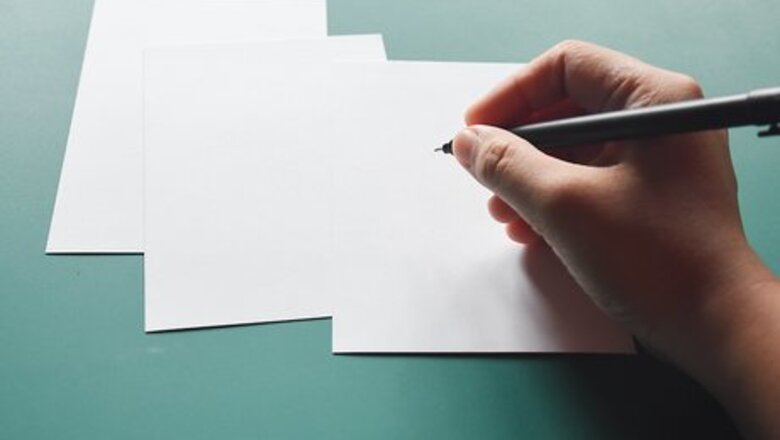
views
Making a Template
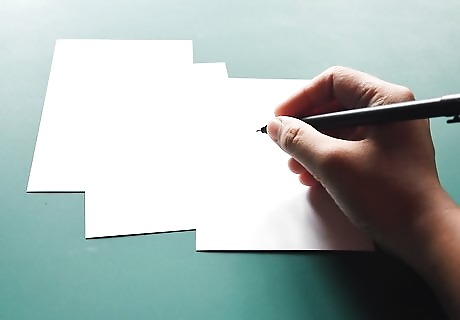
Decide what type of Pokémon you would like to create. Before you get started with anything else, you should first figure out what kind of Pokémon you would like to make. Are you making a version of a pre-existing Pokemon? Your own version of Charizard, perhaps? Or maybe you'd prefer to strike out on your own and invent a new Pokémon altogether? Keeping things like this in mind are important before getting into any of the following steps.

Visit an official card template site. While you might try making a Pokémon card completely by hand, there are several template sites online that offer ample tools to make and print your customized Pokémon cards. In theory, you could use these template sites as a one-stop shop for your card making. However, it's recommended you use them simple as a basic template at first-- part of the enjoyment of making your own cards is the creative expression involved in creating the artwork. Pokemoncardmaker.org is arguably your best bet when it comes to online templates. It's by far the most customizable and compatible with all Pokémon trading card game systems. If you're looking for something more basic, Mypokecard.com will suit your purposes with minimal hassle. If you're not the DIY type, you can upload a .jpg or .png file to the site and use that has your card artwork.
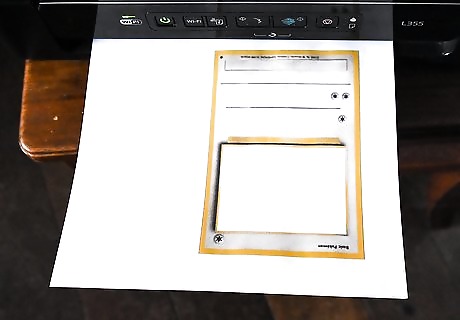
Print out the template. Once you have a basic template ready, you should print it out. If you're wanting to hold onto these cards for a while, your best bet is to invest in some high-quality printer paper. After all, you'll still be saving money in comparison to buying official cards from the store!

Glue the template to a thin cardboard backdrop. Once you have your card templates printed out, the next step is to get them glued to a thin cardboard backdrop. This will give them the characteristic sturdiness of real Pokémon cards.

Cut the cardboard out around the template. Now that you've got our Pokémon cards glued onto a solid back support, it's time to cut them out. Your best bet is to use an exacto knife or some other variety of precision scalpel. That way, you'll be ensured the cleanest, smoothest cut between cards. Although it may feel boring to be so precise with this step, you'll ideally be spending far more time in the illustration phase, so it's well worth it to give your future work the canvas it deserves by taking as much time here as you need.
Illustrating Your Card
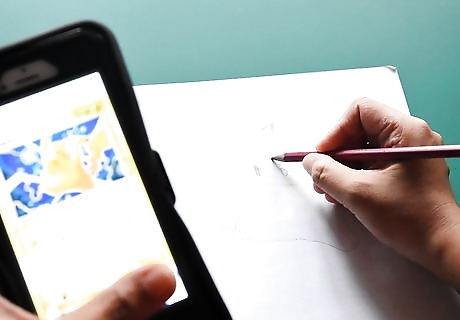
Visualize your Pokémon. Before you set a pen to any kind of paper, you should go into illustrating your creation with some kind of idea what you want it to look like. While creating a Pokémon from the ground up requires inspiration and a familiarity with the existing style of Pokémon, visualizing your illustration is important even if you're using a canon species. You'll only get a small rectangular frame to demonstrate the Pokémons' character and power, so keeping dimensions (as much as style) is important to consider before you get to the applied planning stage. As a starting exercise, you can try copying an official illustration of one of the Pokémon. If you're inventing one of your own Pokémon and are having a difficult time inventing something you're satisfied with, look at real-world animals, which some of the most memorable looking Pokémon are based on. Look up some different kinds of animals, or go to the zoo. If the look of an animal appeals to you, base your Pokémon around it.

Begin a practice draft of the illustration. With your templates now ready, it's time for the fun part-- creating your Pokémon! In an ideal situation, you'll have spent roughly two thirds of the illustration stage in planning, leaving the final third to perfect it as best you can on the card itself. Take a few pieces of scrap paper to work with. You'll have more fun planning out your Pokémon if you first have an idea what you want to do. If you're doing a version of an existing Pokémon, keep some examples of that Pokémon on hand to look at when you're in need of inspiration.
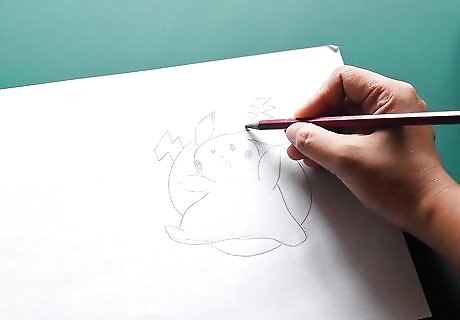
Design a fitting background. The backgrounds on Pokémon card illustrations vary between cards and generations. In some cases, the illustration shows the Pokémon in action in a location; in others, it's a coloured background. Think of the backdrop you would like to showcase your Pokémon in. Is it a leaf-based Pokemon? If so, a natural setting like a forest is better suited than an arctic tundra or a sewer, for example. If you're new to Pokémon card creation, working with a shaded background may be best, as it will help make the illustrating process significantly easier.

Make drafts of your Pokémon. Designing your Pokémon becomes progressively easier the more specific of an idea you have about where you want to go with it. It's recommended you draw two or three drafts of your Pokémon before bringing it to the final card. Each time through, you should experiment with new things and pinpoint what you liked most about your earlier drafts. If you're still having trouble grasping the specific art style of the Pokémon universe, try copying some official Pokémon illustrations first. This will acclimate your hand and eyes to the colourful aesthetic of the franchise.
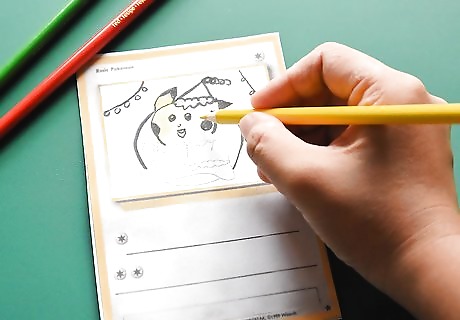
Recreate the finished Pokémon illustration on the card. You shouldn't follow through with the final illustration until you have a solid idea of what the illustration's going to look like. Draw it a couple of times on draft paper, then attempt to replicate it on the card. take your time, starting with pencil, and finalizing with pen or ink. Be as slow and cautious as you can! Some errors may be able to be covered up, but you don't want to risk ruining your hard work over a preventable slip-up. Although pencil crayons may be your go-to favourite, they usually lack the shiny boldness associated with Pokémon cards. Coloured marker pens may lend the best results.
Creating Stats
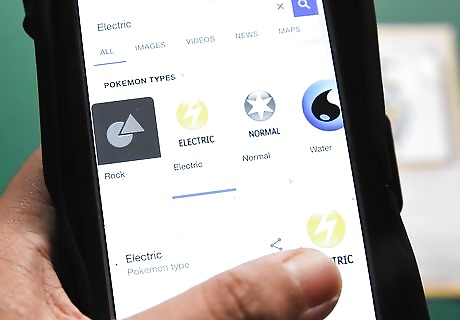
Research your Pokemon's type. If you are designing a Pokémon of your own, you should have a reasonable idea what your Pokemon's role and type are, especially after having illustrated it. An electric-based Pokemon, for example, gravitates towards a much different set of moves than a leaf or psychic-based one. Depending on your experience with the Pokémon franchise, it is almost certainly helpful to look into the different types of Pokémon and the most common attacks for each. If you are making a version of an existing Pokemon, you won't have to worry about stats as much, as you'll already have the existing Pokemon's statistics to fall back on if you're not interested in meddling with them.

Use base stats as a starting point. Base stats are defined as the inherent average values for a given species of Pokemon. Using a given set of base stats is generally far more intuitive than striking out from scratch. From here, you can modify the stats to suit your ends. If you have an invented Pokemon, you can use a similar species' stats as your foundation and change them up as best suits you. Base stats include HP (Hit Points), Attack, Defence, Special Attack, Special Defence, and Speed. For example, a Rattata has 30 base Hit Points and a 56 Attack rating. If you were making a Rattata Pokémon card, you could follow these stats exactly, or you could change them and add your own twist by modifying them slightly or significantly.
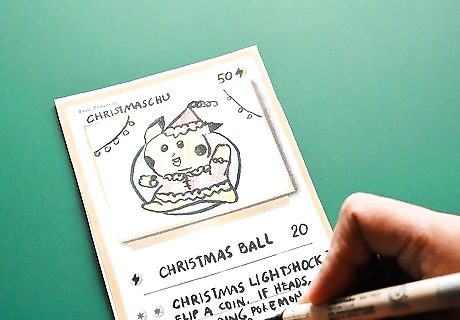
Add attacks and energy stats. If you're intent on using this card in a game, you should include stats such as weakness, resistance and cost. These are generally contingent on the elemental type of Pokémon you are creating. Attacks, on the other hand, require some creativity, and can be a lot of fun to make. Choose existing attacks from similarly powered Pokémon of a common elemental type, or design your own, with considerations given to balance, cost, strategy and power. Lists of all of the known Pokémon attacks may be found online. Take care to note the type (Fighting, Poison, Normal etc.) of attack as well as the power (damage) and power points (cost) of each attack. Use a few of these on your cards before you try making your own. For example, the well-known attack "Blizzard" is Ice-based, has a Power rating of 110, a power points cost of 5, and an accuracy of 70. Of course, if you're using an existing Pokémon for your card creation, you can simply copy the attacks (and stats) from an existing version.

Keep your Pokémon balanced. It's arguably easier (not to mention tempting!) to make your Pokémon as powerful as possible, but that will rob the fun out of putting the card to use. Official Pokémon species are designed with consideration to the way they may be used strategically in-game. If you're just starting out, you may find it's easier to properly balance a common Pokémon as opposed to an uncommon or rare kind. Rarer breeds become more specialized in their abilities, and should only be designed when you have a firm grasp of the way the Pokémon game system functions. Alternatively, you can make the card purely for its aesthetic value, in which case you can completely do without all notions of balance and restraint, should you wish to do so.

Show off your new creation. At last, your card is done! You should make a point of showing it off to your friends. Post pictures of it online. Better still, submit it to an illustration contest. There are card design competitions you can apply to online. If for nothing else, you'll get your artwork showcased and seen by thousands!
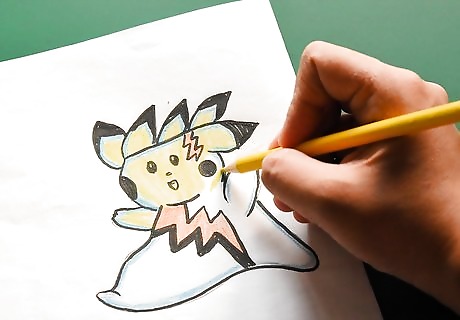
Make new evolved forms of your Pokemon. If you designed a Pokémon of your own and are interested in designing more, you should try designing more advanced (or regressive) evolved forms of your Pokemon. The Pokémon levelling system is built largely around Pokémon evolving into improved forms. They may look different, but retain certain visible traits that denote a kinship between the forms. If you had fun making a Pokemon, you should visualize what your Pokémon could look like at the next stage and repeat the entire process all over again.













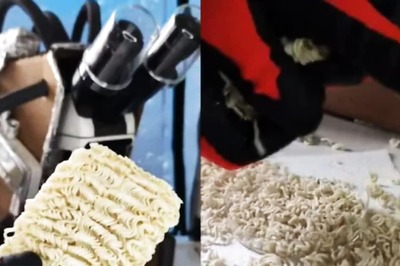
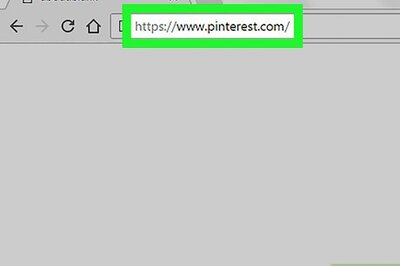

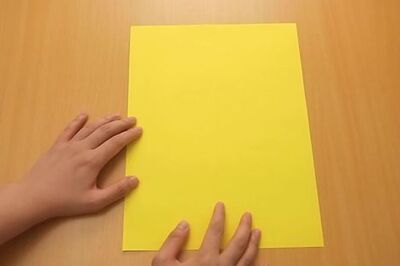

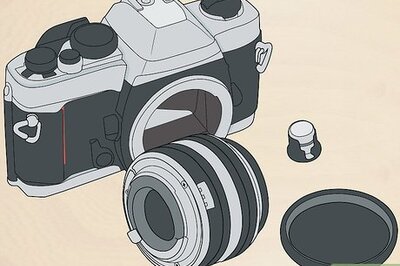
Comments
0 comment